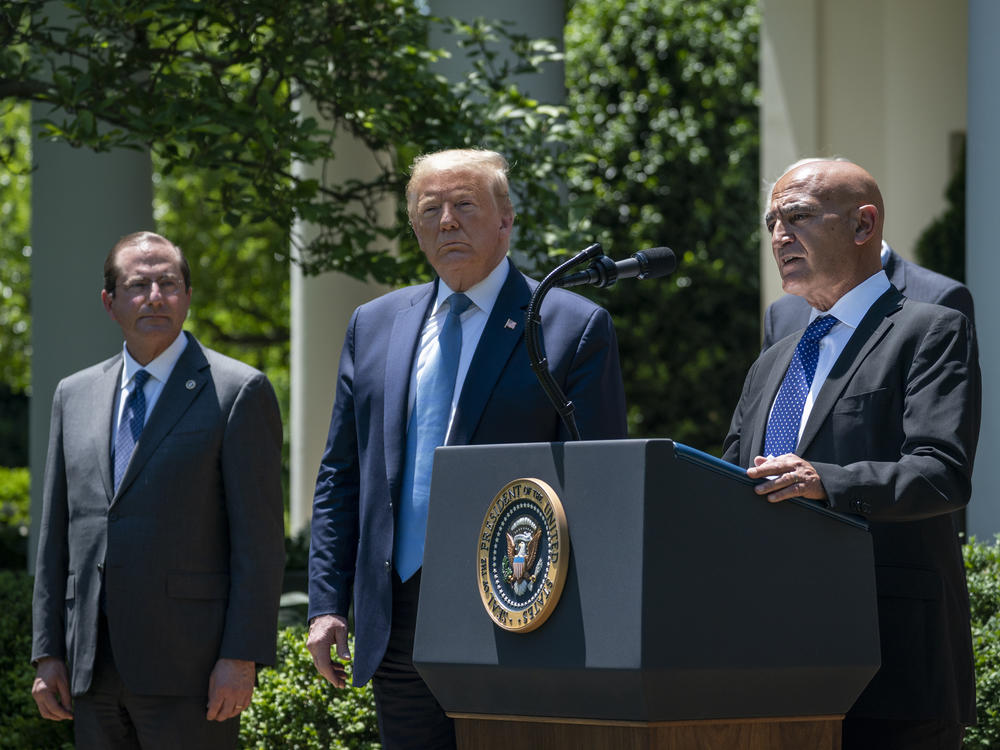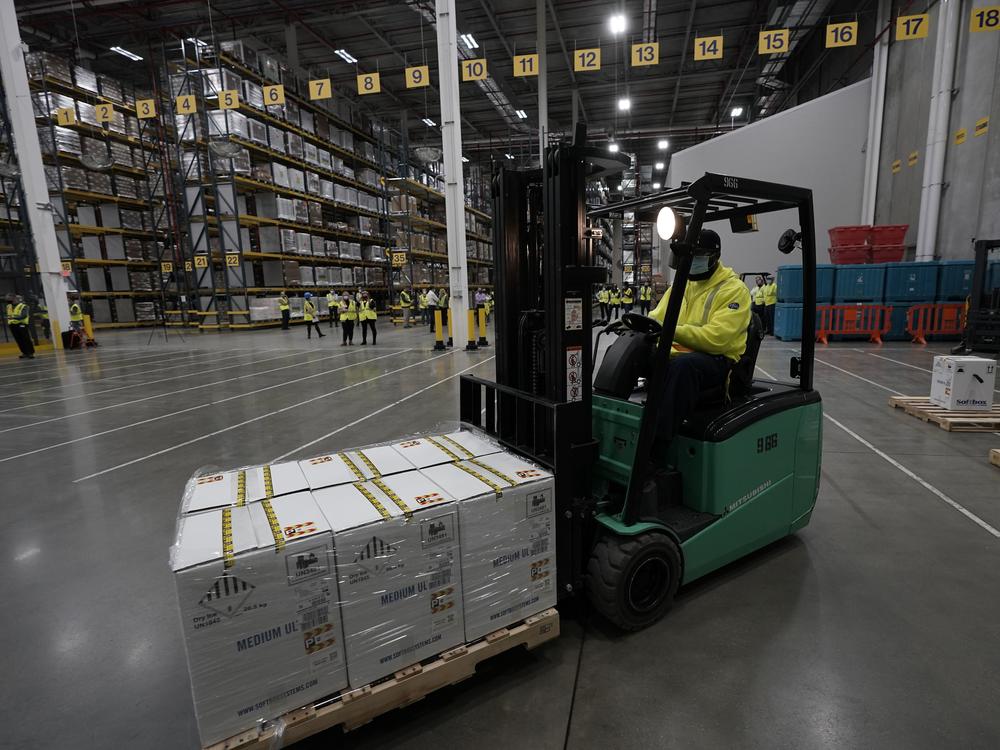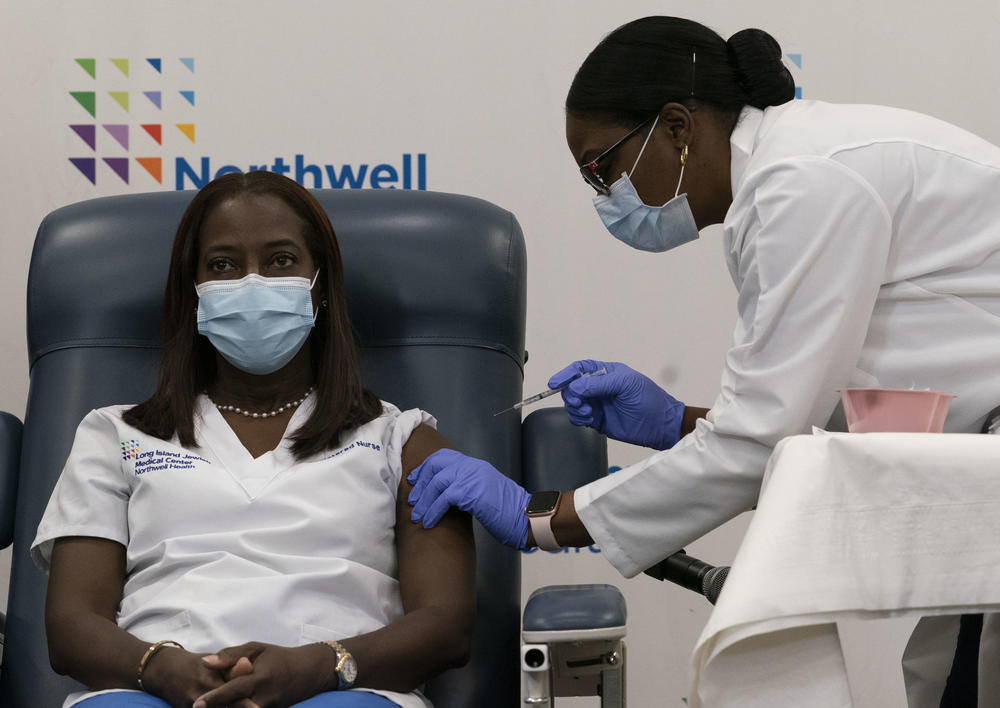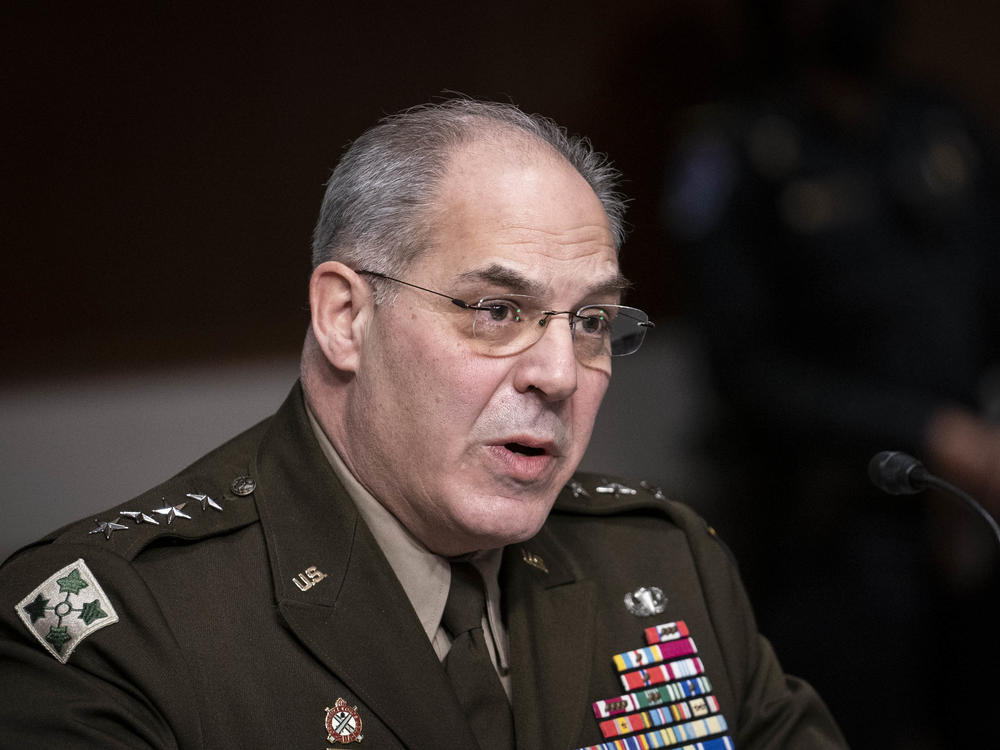Section Branding
Header Content
The U.S. Paid Billions To Get Enough COVID Vaccines Last Fall. What Went Wrong?
Primary Content
It was 17 days before Pfizer's first delivery deadline under its federal COVID-19 vaccine contract, and the company wasn't going to meet it, according to federal records and several people familiar with the matter.
Officials with Operation Warp Speed, the Trump administration's multibillion-dollar push to make a COVID-19 vaccine available in record time, didn't know there was a problem.
Early on the morning of Nov. 10, Health and Human Services Secretary Alex Azar was on the Today show talking to Savannah Guthrie about the "fruits of Operation Warp Speed and America's biopharmaceutical industry."
"Pfizer will be producing and delivering to us approximately 20 million doses of vaccine each month starting at the end of this month, in November," Azar told Guthrie.
But Pfizer was more than a month behind that schedule. It wouldn't finish delivering the doses projected to be due in its contract on Nov. 27 until mid-January, according to an NPR analysis of allocation data from the Centers for Disease Control and Prevention and interviews with several people familiar with the matter.
A day earlier, Pfizer changed a line that had been appearing at the bottom of many of its news releases since the summer. Instead of saying it would make 100 million doses for the world by the end of the year, the company disclosed that it would make 50 million.
Still, Azar had no idea what he was saying was wrong, Paul Mango, Azar's deputy chief of staff, told NPR.
"I can assure you that Alex Azar always conveyed the truth as he knew it," said Mango, who stepped down in January, of Azar's Today comments. "It's just that the truth was being concealed from us."
Pfizer disputes this. "There was not only full transparency, there was show and tell," Pfizer spokesperson Sharon Castillo told NPR.
Meanwhile, cases were climbing. That week, the CDC counted more than 10,000 deaths for the first time since COVID-19 hit.
Operation Warp Speed was depending on Pfizer to deliver more than two-thirds of the vaccines expected in late 2020. But the company's initial contract, worth nearly $2 billion, contained limited reporting requirements to the federal government when there was a delay. As a result, the government didn't know how many doses were really coming, and Pfizer's estimates kept dropping, according to several people familiar with the matter.
Every delay in vaccine production meant that the U.S. was slower to contain the pandemic.
''Big, ginormous assumption'' on manufacturing success
When then-President Donald Trump announced his administration's COVID-19 vaccine initiative in the Rose Garden on May 15, 2020, he said: "It's called Operation Warp Speed. That means big, and it means fast."
He was right. Vaccine development usually takes years. But by spending billions of dollars right away, the Trump administration was trying to condense that timeline to less than a year. A big chunk of the money was earmarked to help companies gear up their manufacturing so they could begin making vaccines even before they knew for sure if they worked.
Moncef Slaoui, the former GlaxoSmithKline executive who had been tapped to be the scientific lead of Operation Warp Speed, paused to address Trump directly during the press conference.
"In fact, Mr. President, I have very recently seen early data from a clinical trial with a coronavirus vaccine. And this data made me feel even more confident that we will be able to deliver a few hundred million doses of vaccine by the end of 2020."
But the reality, said pharmaceutical manufacturing consultant John Avellanet, is that there was no way these companies could ever have delivered that many doses before the end of the year. "That was a fantasy," he said.
Avellanet wasn't involved in Operation Warp Speed, but he has decades of experience consulting for pharmaceutical manufacturers. He said anyone from the industry probably knew — and likely cautioned — Operation Warp Speed that they were making a "big, ginormous assumption of everything going right."
Manufacturers can expect to face unforeseen hurdles when they begin to mass-produce a brand new vaccine. And in a pandemic, there are bound to be supply chain problems as well.
Slaoui acknowledges that the manufacturing was expected to be difficult: "The absence of issues is the miracle. The presence of issues is really what would happen normally."
He told NPR he was optimistic in his Rose Garden statement because of an email he'd seen earlier that morning — his last as a Moderna board member. It made him feel confident enough in the science to believe there would be a vaccine before the end of the year. As to why he said he expected "a few hundred million" vaccine doses by then, he said he was repeating the goal of the project, which was to have enough doses for all Americans.
Overall, Slaoui said having tens of millions of doses of a 95% effective vaccine within a year of the virus' genetic code being sequenced is an "unbelievable" accomplishment. Slaoui said Operation Warp Speed was able to complete tasks in six months that normally take seven years.
Although Slaoui said he wished Pfizer had been more transparent in its communications with the government, he said the supply delays that arose in late 2020 weren't the result of a lackluster effort on the company's part. "It's more because that's life in manufacturing of vaccines," he told NPR. "We had to have aggressive timelines to try and meet them while knowing we may not meet them."
The actual contracts contained much more modest initial delivery goals, according to a review of federal contracts by the Government Accountability Office. By the end of the year, Pfizer and Moderna were expected to deliver 55 million doses of their vaccines in all, according to the review.
Picking vaccine makers for Operation Warp Speed
After the Rose Garden announcement, Slaoui and others began evaluating which vaccine candidates to fund. They'd started with about 100, the administration said, though the full list was never made public. The team quickly whittled the list down to 14 and then whittled it down again to eight.
"Absolutely from Day 1, Pfizer was very clear," Slaoui said. "They don't want any money upfront. They want to take all the financial risk, but they want to have the assurance that there would be a marketplace if the vaccine is efficacious."
The announcements started to roll in: $1.2 billion for AstraZeneca, $1.6 billion for Novavax, another $472 million for Moderna on top of the $483 million the administration already gave the company in April. (Some research and development funding was awarded before Operation Warp Speed was announced, but those awards were wrapped into the project.)
Financial support to jump-start manufacturing wasn't itemized and was instead lumped together with funding for research and bulk purchases, so it's not readily apparent exactly how much went toward manufacturing alone.
The bet on manufacturing was big and risky, but one that promised public health dividends. The idea was that by the time the Food and Drug Administration gave the COVID-19 vaccines a green light, there would be plenty of doses ready and waiting.
"Usually you have ramping up of production right after the vaccine is approved or licensed," said Dr. Saad Omer, who directs the Yale Institute for Global Health. "At-risk manufacturing pulls forward the timeline for vaccinating the masses."
Officials knew early on that Pfizer wouldn't accept federal funding for research and development, but the company was making moves to be part of Operation Warp Speed in its own way. Sometime that summer, it joined a group of academics and companies called the Medical CBRN Defense Consortium, according to an August 2020 notice in the Federal Register. The consortium is run by a defense contract management firm called Advanced Technology International Inc.
Instead of entering into contracts directly with vaccine makers, more than $6 billion in Operation Warp Speed funding would be routed through Advanced Technology International, which then awarded contracts to companies working on COVID-19 vaccines. The contracts could be more tailored to the company's wants and needs and include fewer standard taxpayer protections because Advanced Technology International specializes in nontraditional government contracts.
But Operation Warp Speed needed to be sure all the vaccine studies had similar designs so they could be compared with one another, Slaoui said.
"The hardest one was with Pfizer because they were saying, 'I'm not getting any money from you. So I don't have to agree.' The answer was, 'Yes, we understand. However, if you want to get the commit[ment] to buy the vaccine, we have to be able to compare it to the Moderna vaccine, to the J&J vaccine, to the Oxford vaccine.'"
Although no contract had been announced for Pfizer, the company's chief business officer, John Young, testified alongside other pharmaceutical executives at a congressional hearing on July 21, 2020, about COVID-19 vaccines in development. U.S. Rep. Jan Schakowsky, D-Ill., used her turn to grill the executives about their commitment to keeping vaccine prices affordable, given the significant taxpayer investment in Operation Warp Speed.
When she got to Young, she noted that Pfizer rejected taxpayer funding. She told him she worried that Pfizer did this to "price gouge" without having to answer to Congress.
Young said that wasn't the case. "We didn't accept the federal government funding solely for the reason that we wanted to be able to move as quickly as possible with our vaccine candidate into the clinic," he said. "In regard to your question, let me just say that we recognize that these are extraordinary times, and our pricing will reflect that."
The next day, HHS announced it had reached a deal with Pfizer to purchase 100 million doses for $1.95 billion, or $19.50 a dose, if and only if the vaccine won FDA authorization. The government didn't help fund Pfizer's research as it did the other manufacturers in Operation Warp Speed.
The government later agreed to pay about $15 per dose for the first 100 million doses of Moderna's vaccine, excluding money that went toward research and development.
A bumpy manufacturing build-out
Over the course of the summer and fall, as clinical trials progressed, Operation Warp Speed assisted 23 factories that would be making the vaccines.
For five of the six companies deemed part of Operation Warp Speed, the government was helping secure raw materials, equipment and more. Experts from Operation Warp Speed were also hands-on in helping the factories hire and train workers and develop quality systems.
Pfizer was the exception.
The build-out was bumpy at times, but Operation Warp Speed adapted.
"When you have all of that motion, things happen," Mango told NPR. "Equipment arrives, and it doesn't work. Like pipes are connected in the wrong direction. Plants, you know, all that stuff just ... is a function of a massive scale-up that in many cases was the first time done in history. So it was a very steep learning curve."
A Government Accountability Office report released in April identified multiple chokepoints in the manufacturing process, including limited production capacity of an unidentified "raw material." A domestic factory making it had a fire that delayed delivery between four and 10 weeks. A foreign facility making it had an explosion, prompting its manufacturing to shift to another facility entirely.
The government had limited visibility into what was happening at Pfizer, according to several people familiar with the matter, thanks to the unique contract it negotiated with the federal government.
Slaoui said Pfizer worked "at arm's length" compared with the other companies in Operation Warp Speed.
As a result, government officials weren't in its facilities every day dealing with the growing pains of making millions of doses of messenger RNA vaccine, a new type that had never before been commercially produced.
Castillo, Pfizer's spokesperson, said Operation Warp Speed officials visited Pfizer's Kalamazoo, Mich., vaccine factory three times: in July, November and December.
Frustration with changing vaccine forecasts
In the late summer of 2020, with large-scale clinical trials underway and officials' focus shifting toward distribution once the vaccine got the FDA's blessing, Pfizer told the federal government it was doing better than expected. Instead of the 40 million doses projected in its contract by year's end, it would have 50 million.
For months, everything seemed to be going according to plan.
According to an Aug. 27, 2020, email to Nevada state health officials obtained by American Oversight, the CDC expected 2 million doses of Pfizer's vaccine (designated "vaccine A") to be available in October, with another 10 million to 20 million available in November and 20 million to 30 million available in December.
By the time the first version of the CDC's "interim playbook" for COVID-19 vaccinations was made public on Sept. 16, those numbers hadn't changed. But a second version, published Oct. 29, left out the possibility of any October doses.
Officials on the state and local level grew frustrated with the Trump administration. The number of doses expected in 2020 kept changing, sometimes depending on who was giving the information. Many officials asked for detailed numbers in writing but never got them.
"During the fall, during those meetings, the anticipated number of doses was going up and down," said Claire Hannan, executive director of the Association of Immunization Managers. "I mean, I don't think we ever actually had anything more than just estimates. And there really just wasn't a good sense of how much vaccine would be available and when."
Anytime a federal official said a new number during a press event, immunization managers would whip out their calculators to figure out how much they might get.
"It's very difficult to plan a rollout or plan clinics or plan, you know, which providers are going to get doses if you don't know how many you're going to get," Hannan said. "So, you know, that was very challenging."
And then, a week or so after Azar's optimistic Today show appearance on Nov. 10, Pfizer told the government it wouldn't be able to meet the 40 million dose goal for the end of the year laid out in its contract, but it wasn't yet clear how far behind the company was, according to several people familiar with the matter.
Pfizer spokesperson Castillo said the company was in "constant communication" with Operation Warp Speed, adding that government officials knew that fewer doses were coming and why.
"There were several factors which impacted the number of doses estimated to be available in 2020," she said. "For one, scaling up a vaccine at this pace was unprecedented, and the scale-up of the raw material supply chain took longer than expected. In addition, the outcome of the clinical trial was somewhat later than the initial projection, requiring us to focus additional efforts on clinical trial production."
Although the company didn't deliver 40 million doses, she said that "it was always understood" the numbers in its contract and projections could change.
"The notion of flexibility was laced throughout the July 2020 agreement," she said. "For example, the due date column in the deliverables table was labeled 'Estimated Due Date.' "
Pfizer "in the driver's seat"
Although all the Operation Warp Speed agreements with vaccine makers were a little different, Pfizer's stands out. As part of its eventual federal deal, Pfizer got a tailor-made contract awarded through Advanced Technology International.
In exchange for doing its research and development without government help, Pfizer got a contract that let it retain almost all of its intellectual property rights and forgo the taxpayer protection clauses found in most government contracts that fund inventions.
There were incremental targets in Pfizer's original Operation Warp Speed contract to deliver 20 million doses a month starting in November and ending in March to hit 100 million eventually in all. But the contract said those requirements were "subject to change" based on a variety of factors outside the company's control.
"They're not hard and fast deadlines," said Kathryn Ardizzone, a lawyer at Knowledge Ecology International who reviewed the vaccine contracts. Knowledge Ecology International is a nonprofit public interest group focused on intellectual property.
The contract doesn't specifically give the government the right to verify Pfizer's reasons for not meeting a delivery milestone. That's apparent in the way the contract lays out how vaccines beyond the original 100 million doses would be purchased, Ardizzone said. It just said Pfizer "shall inform the government" how many additional vaccine doses it can make and on what timetable.
"So that seems like Pfizer is in the driver's seat in terms of what the deadlines will be," Ardizzone said. "The language of that just speaks to Pfizer telling the government about when it can accomplish certain goals, rather than the government having the right to verify that."
Overall, the government had no leverage to enforce Pfizer's November deadline once it learned those doses weren't going to be ready, Operation Warp Speed's Mango said.
"What are we going to do, refuse to take doses at any time from the only manufacturer under an EUA [emergency use authorization]? That didn't make sense," Mango said. "So at the time, remember, Moderna didn't get its EUA until Dec. 21, and there was no guarantee on that either. So we had a very difficult, rocky relationship with Pfizer."
Some of that friction arose because Pfizer CEO Albert Bourla said as early as August that the company would have top-line vaccine efficacy data by the end of October but didn't announce it until days after the 2020 election. And Pfizer told the Biden team the good news before telling Operation Warp Speed officials, who were then still in office.
Mango said that Trump's team had secured the needles, syringes and dry ice — not to mention a $2 billion federal contract with Pfizer — yet it felt like the last to know about the strong vaccine efficacy data: "How could we be happy with that?"
Dropping vaccine projections and finger-pointing
By the first week of December, Pfizer told Operation Warp Speed it would have just 22 million doses ready for distribution by the end of the year, several people familiar with the matter told NPR. Before the end of the month, that number dropped again — to 18 million doses.
Castillo, Pfizer's spokesperson, said the company let Operation Warp Speed know earlier that fall that a lower number of doses would be arriving by the end of the year. In November, Operation Warp Speed made planning numbers available to jurisdictions based on an assumed 22.5 million Pfizer doses by the end of the year, she said.
However, not everyone seems to have been briefed at the same time. Some people NPR spoke with said they knew there would be around 22 million doses in November. Others said Pfizer didn't tell them until December.
Slaoui said he remembers it being "quite late."
"We did not have all the information," he said. "And usually I would have a conversation with Albert Bourla, where he would just assure me that everything humanly possible is being done to meet the deadlines."
Slaoui said he believed him, but he didn't know the specifics at the time.
Ultimately, Pfizer released 16 million doses by year-end, according to CDC allocation data.
The shortfall was a sobering setback for the architects of Operation Warp Speed.
"They wouldn't tell us what went wrong," Mango said. "We have no idea. All we know is they didn't deliver the goods, and their estimates of what they were going to deliver diminished significantly from the late summer until the end of December."
For Pfizer's part, spokesperson Castillo said any characterizations that it was behind and failing to be transparent about it are politically motivated "in an effort to harm Pfizer and its COVID-19 vaccine."
"They are not an accurate representation of the overall nature of Pfizer's relationship with the USG [U.S. government] and the vast majority of the government officials who were OWS [Operation Warp Speed] members," she said.
She said the company shared everything with the government, updating it as information became available. The federal government was also part of key Pfizer decisions.
The people involved in Operation Warp Speed kept politics out of it, Slaoui said.
"I worked every day with the commitment that if things became politically influenced, I would leave the operation," he said. "And frankly, I think if it was politically influenced, it would not have worked."
He added, "When we were frustrated with Pfizer, it was more complicated to plan not knowing than knowing. It's just a fact."
Meanwhile, contract negotiations were underway for the United States to purchase its next 100 million doses of Pfizer's vaccine, and they were about to get messy.
On Dec. 8, three days before the FDA authorized Pfizer's COVID-19 vaccine, ex-FDA Commissioner Scott Gottlieb, a member of Pfizer's board of directors, said on CNBC that the U.S. government had waited too long to buy more COVID-19 doses — and it might not get any in the second quarter of the year as a result.
"Pfizer did offer an additional allotment coming out of that plan — basically the second quarter allotment — multiple times," Gottlieb said. When the U.S. hesitated to take the company up on these offers, it entered agreements with other countries, he said. As a result, it wasn't clear how many would be left for the United States.
Azar replied that evening on PBS NewsHour.
"They refused to commit to any other production or delivery by a time certain," he said of the negotiations for more doses with Pfizer. "I'm certainly not going to sign a deal with Pfizer, giving them $10 billion to buy vaccine that they could deliver to us five, 10 years hence. That doesn't make any sense."
What Azar didn't say was that Pfizer was already missing milestones in its original contract.
A public apology for the vaccine shortfall
The second contract wasn't yet resolved when the FDA issued an emergency use authorization for Pfizer's vaccine on Dec. 11.
After that, as Pfizer released doses each week, the government would allocate them to states, making sure there were enough for second doses 21 days later. Then, states would order them, and first doses would be shipped out.
For the week of Dec. 14, the government allocated nearly 3 million first doses, but when it allocated doses for the next week, there was a problem. The estimates initially provided to states via Operation Warp Speed's data system were much higher than the number of doses that were ultimately allocated.
Some states learned that their weekly dose deliveries would be cut nearly in half from the original estimates they received, but they said the federal government didn't tell them why. State immunization employees scrambled for information and had to decide which sites would get fewer doses than they'd planned based on the bad estimates.
Governors took to social media and news conferences to vent their outrage.
"This is disruptive and frustrating," Washington Gov. Jay Inslee tweeted on Dec. 17. "We need accurate, predictable numbers to plan and ensure on-the-ground success."
Pfizer issued a statement that same day, saying it had "millions more doses sitting in our warehouse" but was just waiting for instructions from the U.S. to ship them.
"It was frustrating to see the level of scrutiny on the number of doses, when the miracle was that we have a vaccine," Slaoui said.
A few days later, a top official with Operation Warp Speed weighed in.
"I want to take personal responsibility for the miscommunication," Gen. Gustave Perna, Operation Warp Speed's chief operating officer, said during a Dec. 19 press briefing. "I know that's not done much these days, but I am responsible. And I take responsibility for the miscommunication."
Perna said at the press briefing that jurisdictions asked for planning numbers, and he provided them to the best of his ability, "but vaccine manufacturing is a very arduous technical capability."
There was a disconnect between the forecasted doses available and the number of doses actually releasable to states after quality checks, he said.
"At the end of the day, the number of doses available to us to allocate ended up being lower," he said, adding a personal apology to the governors. "Because this is a herculean effort and we are not perfect, the key is to be transparent and to openly communicate at all levels, step by step. To that end, we are in constant dialogue with both industry partners to assure doses are available."
According to several people familiar with the matter, Perna's apology amounted to taking one for the Operation Warp Speed team.
Even as Pfizer trimmed its projections, Operation Warp Speed was "trying to be incredibly collaborative, maybe to a fault," said a person familiar with Operation Warp Speed, who declined to be identified further, adding that the federal Biomedical Advanced Research and Development Authority in particular didn't want to throw pharmaceutical companies under the bus for failing to meet initial vaccine supply expectations.
"Gen. Perna apologized and we supported him, and it was not at all because the distribution did anything wrong," Slaoui said. He explained that providing a precise number of doses from week to week is incredibly difficult, given the hurdles of early manufacturing.
Perna's apology seemed to help defuse some of the tension. Pfizer and the government came to an agreement for another 100 million doses for $2.05 billion on Dec. 22.
And this time, the U.S. government would use the Defense Production Act to get Pfizer some supplies it needed. Until then, the other five Operation Warp Speed vaccines had at least some help from the federal government under the Defense Production Act, which allowed the vaccine makers to be at the front of the line when they needed certain supplies, equipment, ingredients or more from third-party vendors. Now Pfizer would have that advantage, too.
By the end of the month, Pfizer delivered 16 million vaccine doses to the United States. It was 2 million short of its latest lowered projection and 24 million short of its contractual targets.
Pfizer becomes the dominant vaccine supplier
By late February, Pfizer got its vaccine manufacturing humming and — with Moderna — delivered vaccine doses in high volumes to help bring case counts down. Because it takes so long to make each batch, many of those doses were in production even before Trump and Operation Warp Speed officials left.
But before vaccines could bend the pandemic's curve downward, another 243,000 people would die from COVID-19 from December through February, according to data from Johns Hopkins University.
It was in February that vaccines finally started to have an impact, particularly on nursing home populations, said Dr. William Moss, executive director of the International Vaccine Access Center at the Johns Hopkins Bloomberg School of Public Health.
"I think if we had more doses earlier, we may have been able to have an impact on the mortality rates, I think, in the nursing home population in particular," he said. "But it is more than just having doses."
It's possible that even if the United States had all 55 million vaccine doses expected under the contracts by the end of the year, it wouldn't have had the infrastructure in place to distribute them and get them into people's arms.
Johnson & Johnson, the third COVID-19 vaccine supplier in the U.S., only got the FDA's authorization in late February, and the company has struggled to supply it in volume because of manufacturing issues.
Pfizer said it released all of the 300 million doses it had committed to the U.S. by the middle of July. The company has invested in its global supply chain to make this happen, including doubling its batch sizes, producing its own lipids (the fatty substance that coats the mRNA used in the vaccine) and dry ice and reducing the manufacturing timeline from 110 days to 60 days, spokesperson Castillo said.
In late July, Pfizer agreed to supply the government with an additional 200 million vaccine doses for delivery between October 2021 and April 2022, which would support the government's plan to provide booster shots.
As of Aug. 25, 73% of adults have had at least one dose of the Pfizer, Moderna or the Johnson & Johnson vaccine, according to data from the CDC. And Pfizer is the dominant supplier, accounting for about 57% of the doses administered overall.
"I think it's a good news, bad news story," Yale's Omer said. "The good news is that we eventually got to a pretty substantial number of doses by spring, etc. But I did think that some of their [Operation Warp Speed's] pronouncements ... there seems to be a lack of overlap between what the government officials were assuming versus what was happening."
Slaoui said he doesn't want to minimize the fact that Operation Warp Speed could have immunized millions of people a few weeks earlier had Pfizer met its goals on time, but overall, his team — and Pfizer's — did what they set out to do.
"There was always in the mind of everybody in the operation that the big picture is to have vaccines," Slaoui said. "The very small picture was whether it was 1.5 million this week or 1.8 million."
You can contact NPR pharmaceuticals correspondent Sydney Lupkin at slupkin@npr.org.
Copyright 2021 NPR. To see more, visit https://www.npr.org.





